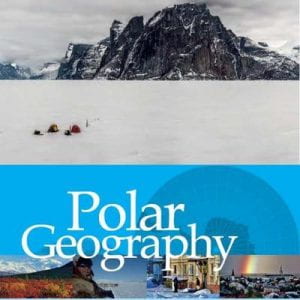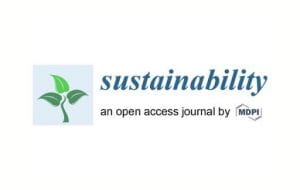Solid waste management in the Arctic
By: Charlene Burns, Robert Orttung, Melissa Shaiman, Leah Silinsky, and Emily Zhang
May 2021 – Highlighting the unique challenges of waste management Northern cities (relatively small size, remoteness, rapidly changing climate), this study compares solid waste management across select Arctic and non-Arctic cities using the International Standard ISO 37120 Sustainable cities and communities — Indicators for city services and quality of life. In contrast to more southerly cities, the study finds that economic development does not explain the amount of waste generated by Arctic residents but that importantly, high levels of political participation correlates strongly with better waste management practices.
Urban planning sustainability metrics for Arctic cities
By: Benjamin DiNapoli and Matthew Jull
December 2020 – In an exploration of the urban planning indicators as defined by the ISO 37120, this article presents a multi-method approach that helps define the area of a city using statistical units and a combination of remote sensing, geospatial analysis, and statistical data collection to calculate these metrics. It also reveals several unique characteristics of Northern cities in the realms of livability, efficiency, socio-economics, and sustainability.
Measuring Sustainability in Russia’s Arctic Cities
By: Robert Orttung, Oleg Anisimov, Svetlana Badina, Charlene Burns, Leena Cho, Benjamin DiNapoli, Matthew Jull, Melissa Shaimain, Ksenia Shapovalova, Leah Silinsky, Emily Zhang, and Yelena Zhiltcova
September 2020 – This study employs a mixed methods approach to cover a wide range of analyses including remote sensing, indicators, cluster analysis, and historical accounts to illuminate a comparative lens of urban sustainability in the Arctic. It marks one of the first efforts of the project to implement the ISO database as a whole to examine sustainability in Northern cities.
Urban Sustainability in the Arctic: Measuring Progress in Circumpolar Cities
Edited by Robert Orttung
June 2020 – This book aims to advance understandings of cities in the far north by applying various elements of the international standard (ISO 37120) to a number of Arctic cities. The book delivers rich case studies and analyses on cities in Alaska, Canada, and Russia in order to see how well the standard measures sustainability and how well it applies to them.
Rethinking Women’s Empowerment: Insights from the Russian Arctic
By: Marya Rozanova and Valeriy Mikheev
February 2020 – This article looks at women’s political empowerment in the Russian Arctic as an example of progress in gender equality. The strong representation of women in Arctic regions, particularly in the Nenets Autonomous Region, is used as a case study to help narrow the research gaps that exist in women’s leadership and representation in government, in both formal and self-government.
Indigenous Peoples, Urbanization Processes, and Interactions with Extraction Firms in Russia’s Arctic
By: Marlene Laruelle
December 2019 – This article is an introduction to the special issue from Sibirica which focuses on demographic changes, migration patters, and complex links and interactions between indigenous communities and extraction firms operating in Russia’s Arctic cities. To read more of the articles published in this issue, see here.
Postcolonial polar cities? New indigenous and cosmopolitan urbanness in the Arctic
By: Marlene Laruelle
October 2019 – This article, published in Acta Borealia, examines two new trends that contribute to the process of Arctic cities becoming postcolonial. The first looks at the arrival of indigenous people, and the second highlights the arrival of labor migrants from abroad. While there is considerable debate as to what a ‘postcolonial’ city is, this work aims to discuss trajectories contributing to Arctic cities moving from a Eurocentric culture towards greater hybridization.
Dealing with the bust in Vorkuta, Russia
By: Nikolay Shiklomanov, Dmitry Streletskiy, Luis Suter, Robert Orttung and Nadezhda Zamyatina
October 2019 – This article presents a case study analysis of the boom-bust cycle in Vorkuta, Russia. By tracing governance paths that affect this study, it offers an analysis of the usefulness of tools such as planning, policy, and informality. The resulting work provides a typology of formal and informal land use tools.
Polar Islam: Muslim Communities in Russia’s Arctic Cities
By: Marlene Laruelle and Sophie Hohmann
August 2019 – This article advances the notion of “Polar Islam” to describe the emergence and dynamics of Muslim communities in Russia’s urban centers. Published in Problems of Post-Communism, the article explores the emergence of Islamic symbols in the urban landscape, challenges around the control of this Polar Islam, and the communities’ cultural adaptation processes in developing a new Arctic identities.
Climate change in Northern Russia through the prism of public perception
By: O.A. Anisimov and Robert Orttung
June 2019 – This article addresses the gap in Western literature and knowledge on the perceptions of climate change in Russia. The public perception of climate change and issues related to it remainly poorly known and this study uses data from modeling, surveys, and observations to give insight on this view.
The three waves of Arctic urbanisation: Drivers, evolutions, prospects
By: Marlene Laruelle
April 2019 – The Arctic Human Development Report identified “Arctic settlements, cities, and communities” as a main gap of knowledge in the region. This paper examines circumpolar urbanisation trends and identifies three historical waves of Arctic urbanisation. Later on, it discusses drivers of the latest urbanisation wave and prospects for urban sustainability in the near future.
Strengthening Food Security Near the Arctic Cirlce: Case Study of Fairbanks North Star Borough, Alaska
By: Robert Orttung, James Powell, James Fox and Claire Franco
February 2019 – Food supply and access is a central concern for residents of cities in remote locations with extreme climatic conditions. This article, using Fairbanks North Star Borough as a case study, speaks to how various stakeholders ensure and work toward improving levels of food security. The suggestions offered by the article point to how collaboration between university-based teams and the public can help improve policy outputs related to food in the Borough.
Assessment of climate change impacts on buildings, structures and infrastructure in the Russian regions on permafrost
By: Dmitry Streletskiy, Luis J. Suter, Nikolay Shiklomanov, Boris Porfiriev and Dmitry Eliseev
February 2019 – This article discusses Russia’s administriative regions and their strategies in containing permafrost to deal with climate change impacts on infrastructure. The study can be applied in land use planning and to help promote the development of climate change adaptation and mitigation in the Russian Arctic.
Principles of strategic planning for the sustainable development of Russian Arctic Cities
By: N.G. Bobylev and A.A. Sergunin
2019 – This article examines the effectiveness of strategic planning by federal legislation and its roles in promoting sustainable development in Russia’s Arctic cities. The study aims to reveal how those principles are being implemented, whether the planning system is cohesive, among other issues. It specifically looks at the cases of Arkhangelsk, Vorkuta, Nickel, Norilsk, Monchegorsk, Murmansk, Salekhard, and Severodvinsk.
Land Cover Change in the Lower Yenisei River Using Dense Stacking of Landsat Imagery in Google Earth Engine
By: Kelsey Nyland, Grant Gunn, Nikolay Shiklomanov, Ryan Engstrom and Dmitry Streletskiy
August 2018 – Published in remote sensing, this article examines land cover change in the Lower Yenisei River region of Arctic Central Siberia. The resulting work provides an effective semiautomated classification strategy for remote sensing in permafrost regions, as well as map products that can be applied to future studies.
#60Above60 Student Guide and Teacher Guide
By: Mary E Short
2017 – These guides are a part of the PIRE project’s #60Above60 initiative. The goal of this initiative is to enhance the perspectives of students about urban life and sustainability issues through creating partnerships and exchanging digital 60-second envrionmental stories with schools in the DC metro area and in the North. These respective guides have great steps, resources, and information for schools to implement as a part of #60Above60.
Access the Student Guide.
Access the Teacher Guide.
Climatic- and anthropogenic-induced land cover change around Norilsk, Russia
By: Kelsey Nyland, Nikolay Shiklomanov and Dmitry Streletskiy
October 2017 – This article outlines the history, development, and industrial activity in Norilsk, revealing important reasons for land cover change in the city. It also discusses temperature increases and human activities, which contribute greatly to Arctic land covers and their evolution.
Biography of a polar city: population flows and urban identity in Norilsk
By: Marlene Laruelle and Sophie Hohmann
October 2017 – This paper discusses Arctic migration and urban sustainability by performing a case study on Norilsk, the first sizeable Northern city entirely built on permafrost. It also investigates the many paradoxes that come with Norilsk urban identity.
A truly Arctic city: an introduction to the special issue on the city of Norilsk, Russia
By: Nikolay Shiklomanov and Marlene Laruelle
September 2017 – This article is an introduction to Polar Geography’s special issue on Norilsk.
The improbable city: adaptations of an Arctic metropolis
By: Matthew Jull
July 2017 – This paper, published in Polar Geography, discusses the role and important legacies of Soviet planning, architecture, and design on the largest and most densely inhabited Arctic city, Norilsk. It presents a timeline and a series of diagrams that explains the urban and architechtural evolution necessary to create a functional and livable city.
Developing Metrics to Guide Sustainable Development of Arctic Cities: Progress & Challenges
By: Luis J. Suter, Carrie Schaffner, Carlson Giddings, Robert Orttung & Dmitry Streletskiy
Fall 2017 – This article, published in the Arctic Yearbook 2017, lays out the research framework for measuring urban sustainability in the Arctic region, addresses the challenges in quantifying sustainability within an easy-to-use index, and shows best practices for making this data and analysis accessible to policymakers and the public.
Digital Environmental Storytelling Connecting to the Arctic: #60Above60 Pilot
By: Laura C. Engel, Mary E. Short, Sarah E. Jennings, Robert W. Orttung & Luis J. Suter
Fall 2017 – This article, published in the Arctic Yearbook 2017, focuses on the design of an environmental digital storytelling pilot project, called #60above60. The major component of #60above60 involves the digital exchanges of teacher and student-led 60-second videos between classrooms in the DC metropolitan area and Arctic urban communities. Through these exchanges, the aim is for students to share urban life perspectives across the 60-degree parallel, which is how this project defines “Arctic”.
Urban Sustainability in the Arctic. Visions, Contexts, Challenges (Washington DC: IERES)
Edited by: Marlene Laruelle and Robert Orttung
Summer 2017 – Proceedings of 4 NSF-funded conferences in Washington DC, St Petersburg and Murmansk
Conquering the permafrost: urban infrastructure development in Norilsk, Russia
By: Nikolay I. Shiklomanov, Dmitry A. Streletskiy, Valery I. Grebenets, Luis Suter
Spring 2017 – This paper discusses the role of permafrost in the urban development of Norilsk, specific human- and climate-induced geotechnical problems related to permafrost, and innovative economically viable solutions to maintain city infrastructure. The analysis of Norilsk’s experiences with permafrost can potentially contribute to the development of sustainable practices for Arctic urbanization.
Sustaining Russia’s Arctic Cities: Resource Politics, Migration, and Climate Change
Edited by Robert W. Orttung
Winter 2016 – Urban areas in Arctic Russia are experiencing unprecedented social and ecological change. This collection outlines the key challenges that city managers will face in navigating this shifting political, economic, social, and environmental terrain. In particular, the volume examines how energy production drives a boom-bust cycle in the Arctic economy, explores how migrants from Muslim cultures are reshaping the social fabric of northern cities, and provides a detailed analysis of climate change and its impact on urban and industrial infrastructure.
Climate Change and Stability of Urban Infrastructure in Russian Permafrost Regions: Prognostic Assessment based on GCM Climate Projections
By: Nikolay I. Shiklomanov, Dmitry A. Streletskiy, Timothy B. Swales, Vasily A. Kokorev
Fall 2016 – One of the most significant climate change impacts on arctic urban landscapes is the warming and degradation of permafrost, which negatively affects the structural integrity of infrastructure. This paper estimates potential changes in stability of Russian urban infrastructure built on permafrost in response to the projected climatic changes provided by six preselected General Circulation Models (GCMs) participated in the most recent Climate Model Inter-comparison Project (CMIP5).
Building an Arctic Urban Sustainability Index: A Reference to Aid in the Selection of Indicators
By Luis Suter and Robert Orttung
Summer 2016 – This paper provides guidance for Arctic PIRE participants on how to construct an Arctic Urban Sustainability Index (AUSI). It reviews several earlier projects and defines guidelines for moving forward.



